Many hands make light work: National staff lend a hand in restoration work on the Rice Lake Plains
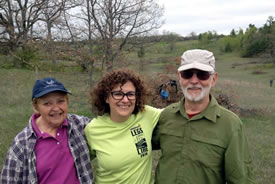
Micheline Beevis, Christine Beevis Trickett and David Beevis, Rice Lake Plains, ON (Photo by NCC)
On a warm autumn day in 1832, Catharine Parr Traill boarded a wagon “comfortably lined with buffalo robes,” and headed from Cobourg, Ontario into the rolling hills of the Rice Lake Plains.
“We now ascended the plains — a fine elevation of land — for many miles scantily clothed with oaks, and here and there bushy pines, with other trees and shrubs," wrote Parr Traill in The Backwoods of Canada — a seminal work in which she described her early years as a settler.
“The soil is in some places sandy, but varies, I am told....The trees, too, though inferior in size to those in the forests, are more picturesque, growing in groups or singly, at considerable intervals, giving a sort of park-like appearance to this portion of the country.”
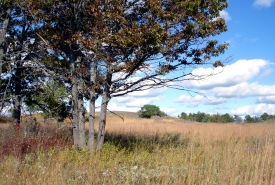
Black oaks on the prairie and savannah, Rice Lake Plains, Ontario (Photo by NCC)
Over the next century and a half, as settlers moved into the area, the landscape changed dramatically. Much of its rolling plains were gradually filled in with Scotch pine — a non-native species that was once the tree of choice for Christmas tree farms and used for greening areas, but which can quickly out-compete other, native species.
Yet here I was on an overcast day only last week, standing in a sandy, open plain that, to the novice, might look much like the one Parr Traill had travelled through almost 180 years ago. To my left, a globally rare black oak tree stretched its branches into a sky that threatened rain. And all around me, staff of the National office of the Nature Conservancy of Canada (NCC) crouched, planting hundreds of native grass seedlings on an open, sandy hill. Somewhere nearby, a grasshopper sparrow buzzed and a white-throated sparrow sang his song of “Oh, sweet Canada.”
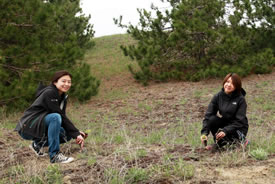
Quincin Chan (NCC) and Nikko Cheung planting native grass plugs (Photo by NCC)
Our group of around 45 office staff and volunteers had taken a rare opportunity to step away from our desks and spend a day planting native grasses and pulling weeds at NCC’s Hazel Bird Nature Reserve. Although it was my first time visiting the property, many of the staff had come here last year to cut down Scotch pine trees. Their efforts were evident throughout the property. Pines that had been sawed with gusto last year now lay brown and dead.
If the landscape is beginning to look more like a black oak savannah and less like a Christmas tree farm, it’s thanks in part to the efforts of Conservation Volunteers and NCC staff, who have taken on the long-term management of the property. As I gazed across the bowl-shaped valley where we worked, NCC Program Manager for Central Ontario Mark Stabb pointed out another field that once had been overrun by Scotch pine, but had been cleared by machine when the property was purchased in 2012.
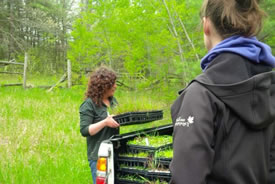
Val Deziel distributes a flat of wild rye for planting (Photo by NCC)
The storm clouds continued to blow their way towards us, but our group of bent-backed planters continued, determinedly digging away in the sandy soil. We were planting native grasses that would grow quickly and shade out other, non-native species in order to return the hill to a more natural savannah. In the space of 45 minutes, we planted 1,500 plugs. Val Deziel, the property steward, was stunned — we’d accomplished in less than an hour what she had estimated would take us more than two.
Slightly chuffed by what we’d been able to accomplish in such a short period of time, we moved on to our next task: pulling juvenile Scotch pines and seedlings. The work was satisfying, as we tugged and yanked at plants that might look short on the surface, but whose roots were often surprisingly long. We quickly became adept at identifying the plants with their upward-pointing seed heads, and fine-tuned our pulling techniques.
As I meandered my way throughout the area, plucking and pulling my way up a gradual embankment, a house wren burbled in a nearby tree, coming out to look at me when I called him with a “whish, whish, whish.” Then he darted away into a nearby bush, likely bored by our staring contest.
“Hazel Bird [for whom the reserve is named] wouldn’t have liked that bird,” commented Mark as we walked back to the parking lot for lunch. Hazel had been a supporter of the local initiative to bring back eastern bluebirds in the Rice Lake Plains by building and installing a network of nest boxes. Mark explained that house wrens often force other birds out of their nest-holes. Nest boxes from the reintroduction program still stand here and there, but most of them were taken down once the population rebounded.
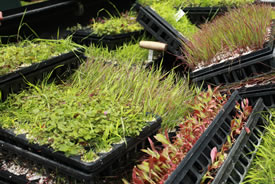
Native grasses (Photo by NCC)
After lunch, we headed back to our first site for some more planting of native grasses, including big blue, Indian grass, little blue, wild rye and more — all grown from seeds collected in the Rice Lake Plains area by volunteers and local residents. The work we were doing was part of an effort to regenerate the historic tall-grass prairie, since its seed bed had been exhausted.
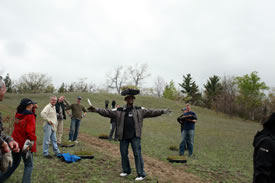
Jamie Demery (NCC) shows how to carry a flat of plants (Photo by NCC)
Once again, our hardy group of volunteers was done in record time, in total planting more than 3,400 plugs. Standing back from our work, we could hardly make out where we’d planted the plugs. But we knew they were there, and I imagined what it would look like in several years, once the seeds from our seedlings spread across the area — a field full of waving grasses blowing in the wind.
Our work complete, Val and Mark took us on a short tour of the property before the rains truly began. We first stopped by the site of a prescribed burn that had happened only a few short weeks ago, intended to clear away weedy invasives and promote the germination of the native seed bank. Throughout the charred soil, little bits of green poked up here and there. When Val returned to the property just days after the fire, the site had already begun to green up.
We continued on our hike, stopping briefly to take in the picturesque rolling hills of the Rice Lake Plains. In the sandy soil, Mark pointed out a ghost tiger beetle hole — the sandy terrain of the area, which straddles the Oak Ridges Moraine, is perfect habitat for this spectral species. Nearby, leaves in a fragrant balsam poplar rustled in the breeze.
Soon enough, it was time for the team to pack up and board the bus headed back to the city. And that’s when the rain, which had politely held off all day, decided to let loose. But as we drove away, we could only think that the rains would be good for our little plants — giving them an extra chance to thrive and grow and helping to bring back the black oak savannah to its historic range.


